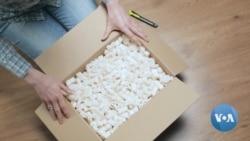ບໍລິສັດແຫ່ງນຶ່ງໃນຄາລິຟໍເນຍ ໄດ້ພັດທະນາໂຟມ ທີ່ເປັນມິດຕໍ່ສິ່ງແວດລ້ອມ ເຊິ່ງສາມາດກາຍ ເປັນຕົວທີ່ພາໃຫ້ເກີດການປ່ຽນແປງໃນຂະແໜງອຸດສາຫະກໍາການຫໍ່ເຄື່ອງໄດ້. Julie Taboh ນັກຂ່າວວີໂອເອ ມີລາຍລະອຽດເພີ້ມເຕີມ, ຊຶ່ງບົວສະຫວັນ ຈະນຳມາສະເໜີທ່ານ ໃນອັນດັບຕໍ່ໄປ.
ໂຟມປລາສຕິກເປັນຜະລິດຕະພັນຫຸ້ມຫໍ່ທົ່ວໄປ ທີ່ເຮັດຈາກຢາງໄຊໂຕຣີນ (styrene) ທີ່ບໍ່ສາມາດຍ່ອຍສະຫລາຍໃນທຳມະຊາດໄດ້, ຊຶ່ງເປັນວັດສະດຸ ທີ່ນໍາເອົາມາໝູນໃຊ້ຄືນໃຫມ່ທົນທານທີ່ຮູ້ຈັກກັນດີວ່າມັນຈະແຕກອອກເປັນປ່ຽງ ນ້ອຍໆ ຊຶ່ງໃນທີ່ສຸດກໍສາມາດໄປຕົກຢູ່ໃນມະຫາສະຫມຸດ, ບ່ອນທີ່ສັດສາວາສິ່ງໃນທຳມະຊາດສາມາດກິນມັນນັ້ນໄດ້.
ແຕ່ດຽວນີ້ ບໍລິສັດຄາລິຟໍເນຍແຫ່ງນຶ່ງໄດ້ພັດທະນາໂຟມຢາງທີ່ເປັນມິດກັບສິ່ງແວດລ້ອມ ທີ່ເຮັດດ້ວຍໄຄຕິເອນ (chitin) ຊຶ່ງເປັນສານທີ່ພົບເຫັນຢູ່ໃນສັດນ້ຳທີ່ມີກາບແຂງເຊັ່ນ ກະປູ, ກຸ້ງທຳມະດາ ແລະກຸ້ງກ້າມໃຫຍ່ ຫລື lobster.
ແລະຢາງຈາກໂຟມປລາສຕິກນີ້ ມັນສາມາດຍ່ອຍສະຫຼາຍໄດ້. ຫົວໜ້າຜູ້ບໍລິຫານ ຫລື CEO ແລະຜູ້ຮ່ວມກໍ່ຕັ້ງບໍລິສັດ Cruz Foam, ທ່ານຈອນແຟລສ໌ (John Felts) ໂອ້ລົມກັບວີໂອເອຜ່ານທາງ Skype ວ່າ:
"ສະນັ້ນ, ສິ່ງທີ່ພວກເຮົາສາມາດເຮັດໄດ້ແມ່ນເອົາວັດສະດຸດັ່ງກ່າວ ແລະ ພັດ ທະນາຂະບວນການທີ່ສາມາດປະດິດໂຟມທີ່ເປັນໂຄງສ້າງທີ່ມີປະສິດທິພາບສູງແທ້ໆໄດ້."
ວັດສະດຸດັ່ງກ່າວມີນ້ຳໜັກເບົາ ແຕ່ແຂງແກ່ນພໍທີ່ຈະປົກປ້ອງບໍ່ພຽງແຕ່ສິ່ງຂອງ ທີ່ແຕກຫັກໄດ້ງ່າຍ ເຊັ່ນເຄື່ອງເອເລັກໂທຣນິກເທົ່ານັ້ນ ແຕ່ຍັງປ້ອງກັນວັດຖຸທີ່ ໜັກ ແລະລາຄາແພງເຊັ່ນ: ຊຸດໂທລະພາບໄດ້ອີກດ້ວຍ.
ສິ່ງທີ່ກະຕຸ້ນທ່ານແຟລສ໌ ແລະຜູ້ຮ່ວມກໍ່ຕັ້ງບໍລິສັດຂອງທ່ານແມ່ນຄວາມຮັກຂອງ ພວກເຂົາເຈົ້າທີ່ມີຕໍ່ມະຫາສະຫມຸດ.
"ໃນຖານະທີ່ເປັນນັກຂີ່ແຜ່ນກະດານລອຍຟອງທະເລ ຫລື surfer, ພວກເຮົາບໍ່ ມັກຫລາຍທີ່ໄດ້ເຫັນມົນລະພິດຈາກຢາງປລາສຕິກ ອັນມະຫາສານເຂົ້າໄປໃນມະ ຫາສະໝຸດໃນທຸກໆປີ, ແລະພວກເຮົາກໍຮູ້ແລ້ວວ່າ ຕ້ອງໄດ້ມີການແກ້ໄຂບັນຫາ ທີ່ດີກວ່າເກົ່າຢູ່ທີ່ນັ້ນ."
ບໍລິສັດ Cruz Foam ບໍ່ແມ່ນແຕ່ເປັນບໍລິສັດດຽວເທົ່ານັ້ນ ທີ່ມີຈໍານວນເພີ່ມ ຂຶ້ນທີ່ເຮັດສິ່ງທີ່ເປັນການດຶງດູດຄວາມປາດຖະໜາຂອງບໍລິສັດ-ແລະຂອງຜູ້ບໍລິ ໂພກທັງຫລາຍທີ່ກາຍມາເປັນມິດຕໍ່ສິ່ງແວດລ້ອມ, ອີງຕາມທ່ານສກັອດ ແຄສແຊລ (Scott Cassel), ຜູ້ສະແຫວງຫາການຫນັບສະຫນູນທາງດ້ານສິ່ງ ແວດລ້ອມ.
ທ່ານເປັນ CEO ແລະຜູ້ກໍ່ຕັ້ງສະຖາບັນ Product Stewardship, ເຊິ່ງມີ ພາ ລະກິດເພື່ອຫຼຸດຜ່ອນຜົນກະທົບຕໍ່ສຸຂະພາບແລະສິ່ງແວດລ້ອມຂອງຜະລິດ ຕະພັນສຳລັບຜູ້ບໍລິໂພກໃນຕະຫລອດວົງຈອນຂອງມັນ. ທ່ານໄດ້ໂອ້ລົມກັບວີໂອເອ ຜ່ານທາງ Skype ວ່າ:
"ໂດຍມີຜົນກະທົບຂອງການປ່ຽນແປງດິນຟ້າອາກາດ, ໂດຍທີ່ມີວິກິດການດ້ານ ຢາງປລາສຕິກທົ່ວໂລກ ທີ່ພວກເຮົາໄດ້ເຫັນ, ຜູ້ບໍລິໂພກກໍາລັງຄິດກ່ຽວກັບ ເລື່ອງນີ້ຢູ່ອີ່ຫລີດຽວນີ້. ພວກເຂົາເຈົ້າກໍາລັງຊຸກຍູ້ໃຫ້ບໍລິສັດຄິດໃຫ້ດີກວ່າເກົ່າ ແລະຄິດເຖິງໄລຍະທີ່ຍາວກວ່າ.”
ທ່ານແຄສແຊລ, ຜູ້ສະແຫວງຫາການສະໜັບສະໜູນດ້ານສິ່ງແວດລ້ອມກ່າວ ຜ່ານທາງ Skype ຕໍ່ໄປວ່າ:
"ແລະສິ່ງທີ່ບໍລິສັດ Cruz Foam ໄດ້ເຮັດແມ່ນການພັດທະນາການແກ້ໄຂບັນ ຫາທາງເທັກໂນໂລຈີແບບປະດິດສ້າງ, ຫນ້າສົນໃຈທີ່ໃຊ້ວັດສະດຸທີ່ດີແທນໃຫ້ ສິ່ງທີ່ບໍ່ດີ."
ໃນປັດຈຸບັນບໍລິສັດ Cruz Foam ກໍາລັງທຳການສົນທະນາຫາລື ກັບບໍລິສັດ ອາເມຣິກັນຈໍານວນນຶ່ງເພື່ອສະຫນອງຕາມຄວາມຕ້ອງການ ການຫຸ້ມຫໍ່ທີ່ມີການປ້ອງກັນດີຂອງເຂົາເຈົ້າໃຫ້.
ບໍລິສັດນີ້ຫວັງວ່າມື້ນຶ່ງຈະສາມາດໃຊ້ວັດສະດຸທໍາມະຊາດທົດແທນໃຫ້ຢາງປລາສ ຕິກ ທີ່ຜະລິດໂດຍອີງໃສ່ນ້ໍາມັນທັງຫມົດນັ້ນໄດ້ເພື່ອຜົນປະໂຫຍດຂອງໜ່ວຍໂລກ.
ອ່ານຂ່າວນີ້ເພີ້ມເປັນພາສາອັງກິດ
A California company has developed an eco-friendly version of plastic foam that could become a game changer in the packaging industry. VOA’s Julie Taboh has more.
Plastic foam is a common packing product made of nonbiodegradable styrene ((STY-reen)), a tough-to-recycle material known to break into small pieces that can end up in oceans, where wildlife can ingest it.
But now a California company has developed an eco- friendlier version of plastic foam made of chitin ((KITE-en)), a substance found in the shells of crustaceans like crabs, shrimp and lobster.
And unlike plastic foam, it’s biodegradable. Cruz Foam CEO and co-founder John Felts spoke with VOA via Skype:
John Felts, Cruz Foam Co-founder via Skype: “So, what we were able to do is take that material and really develop a process that could create a structural foam that had that high performance.”
The material is lightweight but strong enough to protect not only fragile items like electronics but also heavy and expensive objects such as television sets.
What motivated Felts and his co-founder was their love of the ocean.
“As surfers, we hated seeing the enormous amount of plastic pollution entering it every year, and we knew there had to be a better solution out there.”
Cruz Foam is just one of a growing number of companies that are appealing to corporations’ – and consumers’ desire, to become eco-friendly, says environmental advocate Scott Cassel.
He is CEO and founder of the Product Stewardship Institute, whose mission is to reduce the health and environmental impact of consumer products across their life cycle. He spoke with VOA via Skype.
Scott Cassel, Environmental Advocate via Skype: “With the impacts of climate change, with the global plastic crisis that we have had, the consumers are really thinking about this right now. They're pushing companies to think better and think more longer range.”
Scott Cassel, Environmental Advocate via Skype:
“And what Cruz Foam has done is developed an interesting, innovative technological solution that uses a good material in place of a bad one.”
Cruz Foam is currently in discussions with several American corporations to provide their protective packaging needs.
It hopes one day to replace all petroleum-based plastics with natural materials for the sake of the planet.





